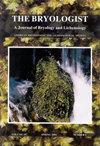Recent literature on bryophytes — 124(4)
IF 1.5
4区 生物学
Q4 PLANT SCIENCES
引用次数: 0
Abstract
Abderrahman, S. M. 2004. Nuclear DNA content of haploid and diploid Physcomitrium pyriforme using DAPI staining. Korean Journal of Genetics 26(3): 245–250. Abderrahman, S. M. & N. Modallal. 2009. Relative DNA content of three cytotypes of Pohlia nutans. Jordan Journal of Biological Sciences 2(3): 129–133. [‘‘Polyploidy has played a main role in generating the cytotypes. It seems likely that the haploid, diploid and triploid races of P. nutans are of long standing autopolyploid.’’] Achoual, K., I. Fadel, A. Dabghi, K. Saadi, J. Dahmani & N. Belahbib. 2021. Amblystegium serpens and Oxyrrhynchium speciosum two new species for the bryoflora of Morocco. Plant Cell Biotechnology and Molecular Biology 22(31 & 32): 86–95. Alisha, Z. Szweykowska-Kulińska & I. Sierocka. 2021. [Abstract] Evolutionary and functional analysis of SQUAMOSA-PROMOTER BINDING PROTEIN-LIKE (SPL) gene family in Marchantia polymorpha, an emerging model plant system. The Bryological Times 152: 137. Althoff, F. & S. Zachgo. 2020. Transformation of Riccia fluitans, an amphibious liverwort dynamically responding to environmental changes. International Journal of Molecular Sciences 21(15): 5410 [1–16]. [doi: 10.3390/ijms21155410.] Althoff, F. & S. Zachgo. 2021. [Abstract] Riccia fluitans, an informative amphibious liverwort to study plant terrestrialization. The Bryological Times 152: 113. Anonymous. 2021. Vragen aan. . . Bart van Tooren. Buxbaumiella 120: 76. [In Dutch with English abstract; incl. photo of van Tooren.] Aruna, K. B., A. M. Sathisha & M. Krishnappa. 2013. Bryophyte diversity in semi evergreen forest of Chikmagalur district, Karnataka. Kuvempu University Science Journal 6: 1–7. Asadboland, R., M. R. Eslahi, A. R. Iranbakhsh & S. Shirzadian. 2021. [Abstract] Growth inhibition effects of some mosses on the phytopathogenic fungus ‘‘Bipolaris sorokiniana.’’ The Bryological Times 152: 138. [‘‘In vivo observations had also indicated that, ethanolic extract of Eucladium verticillatum can prevent the growth of mycelium and in some cases, had similar effects as Benomyl.’’] Asthana, A. K. & P. Srivastava. 2021. Riccia boliviensis Jovet-Ast, new to Asia from India with disjunct distribution beyond South America. National Academy Science Letters 44: 155–159. [doi: 10.1007/s40009-020-00957-5.] Atwood, J. J. & W. R. Buck. 2021. Recent literature on bryophytes — 124(2). The Bryologist 124(2): 281–312. [doi: 10.1639/0007-2745124.2.281.] Averis, A. B. G. 2020. Drizzle, Midges (Misery!) and Moss. Welcome to the Rainforests of Britain and Ireland! 86 pp. Published by the author. [booklet avilable at: http://www. benandalisonaveris.co.uk/wp/wp-content/uploads/2020/11/ rainforests_-_ben_averis_-_june_2020__version_with_images_ at_low_resolution_.pdf.] Awasthi, A., M. Singh, G. Rathee & R. Chandra. 2020. Recent advancements in synthetic methodologies of 3-substituted phthalides and their application in the total synthesis of biologically active natural products. RSC [Royal Society of Chemistry] Advances 10(21): 12626–12652. [doi: 10.1039/ D0RA00701C; ‘‘Plants, fungi, bacteria, and liverworts have been different sources for phthalides.’’] Azevedo de Oliveira, B., M. F. de Oliveira & A. S. Maciel-Silva. 2021. What can bryophyte diversity on cangas (ironstone outcrops) teach us? Journal of Vegetation Science 32(3): e13029. [doi: 10.1111/jvs.13029.] Bakalin, V. A., S.-S. Choi & S. J. Park. 2021. Revision of Gymnomitriaceae (Marchantiophyta) in the Korean Peninsula. PhytoKeys 176: 77–110. [doi: 10.3897/phytokeys.176.62552.] Bakalin, V. A., V. E. Fedosov, D. G. Long, A. V. Fedorova & Y. D. Maltseva. 2021. Protoharpanthus gen. nov. (Harpanthaceae) — a relict relative of Harpanthus from the Sino-Himalaya. The Bryologist 124(2): 218–229. [doi: 10.1639/0007-2745-124.2.218. New: Protoharpanthus Bakalin, Fedosov & D.G. Long gen. nov., P. sinensis Bakalin, Fedosov & D.G. Long sp. nov.] Bakalin, V. A. & K. G. Klimova. 2020. Hepaticae Rossicae Exsiccatae XV: nos. 351–375. Kola Science Center/Russian Academy of Sciences, The Polar-Alpine Botanical Garden-Institute, Apatity/ Kirovsk/Vladivostok, Russia. [Scheda of exsiccatae.] Bakalin, V. A., K. G. Klimova, V. S. Nguyen & H. M. Nguyen. 2020. Hepaticae Vietnamenses Exsiccatae 1: nos. 1–30. Russian Academy of Sciences, Far Eastern Branch, Botanical GardenInstitute and Vietnam Academy of Science and Technology, Institute of Ecology and Biological Resources, Vladivostok and Hanoi. [Scheda of exsiccatae.] Bakalin, V. A., A. A. Vilnet, K. G. Klimova, W.-Z. Ma, S.-S. Choi & J. Hentschel. 2021. Hidden in plain view: an example from Ptilidium (Ptilidiaceae, Marchantiophyta). Phytotaxa 510(1): 29–42. [doi: 10.11646/PHYTOTAXA.510.1.3. ‘‘Both latter taxa (Ptilidium ciliare and P. pulcherrimum) are only slightly diverged genetically, and sometimes morphological discrimination is challenging such that both are better treated as varieties or 3 Corresponding author’s email: john.atwood@mobot.org The cumulative database for this bibliographic series is available in a searchable format online at http://www.tropicos. org, and by clicking on the References tab. Thanks to the authors who send us reprints or electronic versions of their publications for indexing. DOI: 10.1639/0007-2745-124.4.610苔藓植物最新文献-124(4)
org本书目系列的累积数据库以可搜索的格式在线提供,网址为http://www.tropicos.org,并点击参考资料选项卡。感谢那些向我们发送其出版物的转载或电子版本以供索引的作者。DOI:10.1639/0007-2745-124.4.610
本文章由计算机程序翻译,如有差异,请以英文原文为准。
求助全文
约1分钟内获得全文
求助全文
来源期刊

Bryologist
生物-植物科学
CiteScore
2.40
自引率
11.10%
发文量
40
审稿时长
>12 weeks
期刊介绍:
The Bryologist is an international journal devoted to all aspects of bryology and lichenology, and we welcome reviews, research papers and short communications from all members of American Bryological and Lichenological Society (ABLS). We also publish lists of current literature, book reviews and news items about members and event. All back issues of the journal are maintained electronically. The first issue of The Bryologist was published in 1898, with the formation of the Society.
Author instructions are available from the journal website and the manuscript submission site, each of which is listed at the ABLS.org website.
All submissions to the journal are subject to at least two peer reviews, and both the reviews and the identities of reviewers are treated confidentially. Reviewers are asked to acknowledge possible conflicts of interest and to provide strictly objective assessments of the suitability and scholarly merit of the submissions under review.
 求助内容:
求助内容: 应助结果提醒方式:
应助结果提醒方式:


